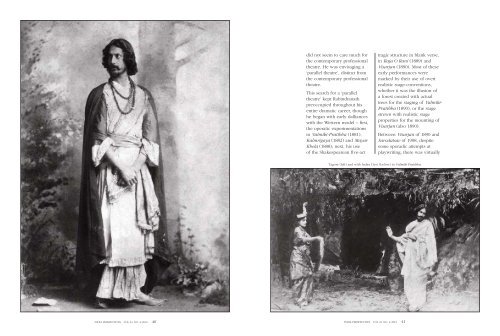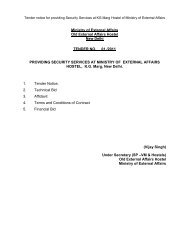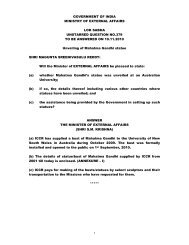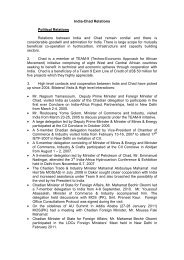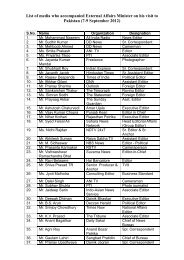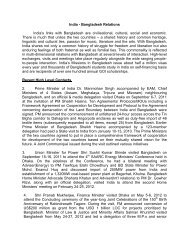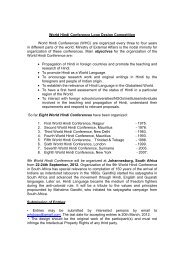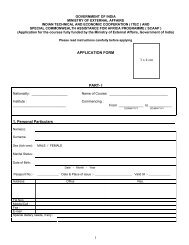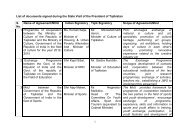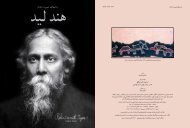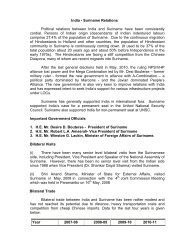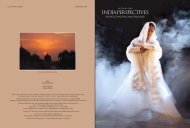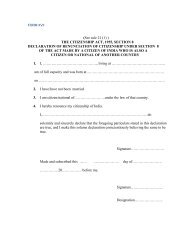did not seem to care much forthe contemporary pr<strong>of</strong>essionaltheatre. He was envisaging a‘parallel theatre’, distinct fromthe contemporary pr<strong>of</strong>essionaltheatre.This search for a ‘paralleltheatre’ kept Rabindranathpreoccupied throughout hisentire dramatic career, thoughhe began with early dallianceswith the Western model – first,the operatic experimentationsin Valmiki-Pratibha (1881),Kalmrigaya (1882) and MayarKhela (1888); next, his use<strong>of</strong> the Shakespearean five-acttragic structure in blank verse,in Raja O Rani (1889) andVisarjan (1890). Most <strong>of</strong> theseearly performances weremarked by their use <strong>of</strong> overtrealistic stage-conventions,whether it was the illusion <strong>of</strong>a forest created with actualtrees for the staging <strong>of</strong> Valmiki-Pratibha (1890), or the stagestrewn with realistic stageproperties for the mounting <strong>of</strong>Visarjan (also 1890).Between Visarjan <strong>of</strong> 1890 andSarodatsav <strong>of</strong> 1908, despitesome sporadic attempts atplaywriting, there was virtually<strong>Tagore</strong> (left) and with Indira Devi (below) in Valmiki Pratibha.INDIA PERSPECTIVES VOL 24 NO. 2/2010 40 INDIA PERSPECTIVES VOL 24 NO. 2/2010 41
a gap <strong>of</strong> almost eighteenyears. The return to seriousdrama with Sarodatsav in 1908marks a major shift, not merelydramaturgical or theatricalbut even ideological. On theone hand, Rabindranath stillhad a sense <strong>of</strong> regard for the“great English” (whom heassociated with all that wasgood in the English culture)and distinguished them fromthe “little English” (whom helocated in the colonial masterswho had taken control <strong>of</strong> thiscountry). On the other hand, hewas influenced by the upsurge<strong>of</strong> the nationalist/anti-colonialideology that was increasinglygaining momentum.Oscillating between the two,Rabindranath had started to‘imagine’ a modern Indiannation that would recover much<strong>of</strong> its lost ancient glory. Thisurge was articulated in severalpoems, songs and essayscomposed during this period(among which were essayslike “Prachya O PaschatyaSabhyata”: 1901, “Nation ki”:1901, “Bharatvarsher Samaj”:1901, “Bharatvarsher Itihas”:1902, “Swadeshi Samaj”:1904). He was making aconscious departure from theBritish system <strong>of</strong> educationby founding a school inSantiniketan, approximating theIndian concept <strong>of</strong> a tapovan(1901). He was even activelyinvolved in the political protestsagainst the British-policy <strong>of</strong>partitioning Bengal; he steppedinto the streets singing songsand celebrating Rakshabandhanbetween members <strong>of</strong> the Hinduand Muslim communities (1905).Alongside, he was also‘imagining’ a new kind <strong>of</strong>theatre, which would besignificantly different from thecolonial mimicry then practisedon the public stage. This newtheory <strong>of</strong> theatre is formulatedin the essay “Rangamancha”(1903), in which he voiceshis disapproval <strong>of</strong> Westerntheatrical models, particularly <strong>of</strong>the realistic kind, and suggests areturn to our indigenous culturaltraditions. Rabindranath’sespousal <strong>of</strong> the cause <strong>of</strong> jatra isparticularly significant becausethis indicates his disapproval <strong>of</strong>both the colonial and the urbannature <strong>of</strong> the contemporaryBengali theatre. In the prefaceto Tapati (1929) he is critical<strong>of</strong> overt realism in theatre,particularly the use <strong>of</strong> paintedscenery. In imagining a “paralleltheatre”, he was trying to ridit <strong>of</strong> the unnecessary colonialtrappings and urban inflections.He was seeking to ensure thatthe imagination <strong>of</strong> the audiencewas not limited.When he moved to Santiniketanand the open-air environs <strong>of</strong> theashrama-school, Rabindranathwas able to put into practicehis notions <strong>of</strong> a ‘new’/‘parallel’theatre – both in the dramaticand theatrical languages –particularly in the productions<strong>of</strong> seasonal plays likeSarodotsav and Phalguni. Forthe 1911-Sarodatsav production(in which Rabindranath playedthe Sannyasi, or the ascetic),the students are reported tohave “decorated the stage withlotus flowers, kash, leavesand foliage”. Rabindranathallowed only a blue backclothto stand in for the sky, andmade Abanindranath removethe mica-sprinkled umbrella:“Rabikaka did not like it, andasked, ‘Why the royal umbrella?The stage should remain clearand fresh’; so saying, he hadthe umbrella removed.” Thebare stage was the appropriate<strong>Tagore</strong> as Raghupati in Visarjansetting for the two scenes <strong>of</strong>this play: the first located on theroad; the second, on the banks<strong>of</strong> the River Betashini.Again, for the first performance<strong>of</strong> Phalguni at Santiniketan(25 April 1915), the stage décorwas in tune with this poeticstructure <strong>of</strong> the play. As SitaDevi reminiscences, “the stagewas strewn with leaves andflowers. On the two sides weretwo swings on which two smallboys swung gleefully to theaccompaniment <strong>of</strong> the song…”Indira Devi, referring to a1916-Jorasanko performance(a charity show for the Bankurafamine), comments: “In place <strong>of</strong>the previous incongruous Westernimitation, a blue backdrophad been used; it is still usednow. Against it, was a singlebranch <strong>of</strong> a tree, with a singlered flower at its tip, under apale ray <strong>of</strong> the moonshine.”The reviewer <strong>of</strong> The Statesman(1 February 1916) noted: “‘Phalguni’ is a feast <strong>of</strong> colourand sound and joy. 1 ”Around this time, Rabindranathalso wrote what were arguablyhis maturer plays – Raja (1910),Dakghar (1917), Muktadhara(1922), Raktakarabi (1924)and Tasher Desh (1933). In1 Cited in Rudraprasad Chakrabarty, RangamanchaO Rabindranath: Samakalin Pratrikiya,pp. 125-126.INDIA PERSPECTIVES VOL 24 NO. 2/2010 42 INDIA PERSPECTIVES VOL 24 NO. 2/2010 43


